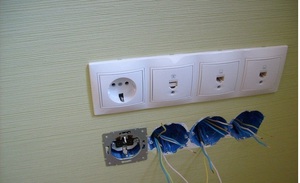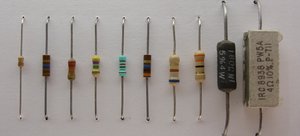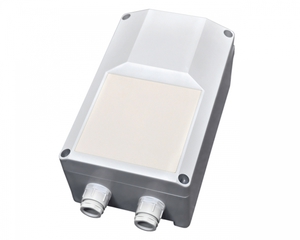Connection of electricity meters: because of, schemes and instructions, how to connect single-phase to the network
Each apartment has an electric meter - a device for metering electricity consumption. When a user enters into a contract with an electricity supplier, then the purchase and installation of a meter is mandatory. Without this device in this situation can not do.
Installation of electricity meters can be carried out by a qualified specialist. But this is not always possible, and the installation procedure itself can be performed by the user. Given that fact, that you can always find detailed instructions describing the entire installation, then even a less experienced user will be able to install the meter.
The article below will talk about the installation of different types of electricity meters, as well as some nuances of this process.
Installation of single-phase electric meters
Electric meters can be single-phase and three-phase, direct and indirect inclusion. We will not interfere with everything in a heap, so it's best to start with single-phase and so on, considering each connection of each of the types of meters in more detail.
To install a single-phase electric meter, need to be considered, connecting such a device directly to the power line break. We must not forget, that no devices should be connected to the connection of the meter to the network, consuming electricity. You should also remember, that the input circuit breaker should be installed. This is done for that, that there is protection of the power supply line in front of the meter. The switch will be very useful in this case, when the counter will change. Its presence will allow to avoid de-energization of all line of supply.
To protect and depart line, care should be taken to stop the circuit breaker after the meter. This will also protect the meter in the event of faults in other electricity consumers.
When installing the meter should carefully consider the wiring diagram. Usually this circuit is on the terminal cover, on its back.
You have to remember, that single-phase electricity meters have four terminals for connection:
- Phase wire input.
- Zero wire input.
- Phase wire output.
- Zero wire output.
You can see, that it is not difficult to remember all the terminals. Power cord, following the input circuit breaker, must be connected to the terminals 1 and 3, pre-stripping the wires from the insulation by about 15 mm. The wires should also be cleaned and removed, which are connected to the terminals 2 and 4, which fully complies with the wiring diagram, located on the cover of the meter.
The above-described scheme of connection of electric meters is suitable for garages, country houses and apartments in high-rise buildings.
How to connect a three-phase meter
To install a three-phase meter, you can use one of the available connection options. There are only two such options: direct connection and indirect. Each user can choose the connection method, which will seem to him more convenient and priority.
If it is necessary to take into account the consumption of a relatively small number of low-power three-phase consumers, the electricity meter must be installed in the power supply gap.
Otherwise, when it is necessary to take into account and exercise control over sufficiently powerful three-phase consumers, whose currents exceed the nominal values, it is necessary to install additional current transformers.
If the user is considering installing an electric meter for a country house or his small production, then only one meter can be installed, which will be designed for maximum current up to 50 ampere. Connecting such an electric meter is very similar to connecting a single-phase meter, described above, only with that difference, that in this case at connection of the three-phase counter the three-phase power supply network is used. It follows from all this, that the three-phase electric meter will be equipped with a large number of terminals.
Direct connection of three-phase electric meter
To begin with, the conductive wires should be stripped of insulation, then they need to be connected to a three-phase circuit breaker. After connecting to the machine, the wires must be connected to the terminals 2, 4 and 6. The output of the phase wires, respectively, is carried out by connecting them to 1, 3 and 5 Clem. To the terminals 7 you need to connect the input neutral wire, and the output is already to the terminal 8.
To ensure protection, circuit breakers should be installed after the meter. The presence of three-phase consumers involves the installation of three-pole machines.
To three-phase meters, in principle, can be connected and single-phase, more familiar, electrical appliances. For this purpose it is necessary to carry out connection of the unipolar automatic machine from any departing phase of the electric meter, while the second wire needs to be taken from the neutral zero bus.
When installing several groups of single-phase consumers, then it is necessary to make their even distribution, power the switches after the meter from different phases.
Indirect connection of a three-phase electric meter
There are cases, when the load of all devices is consumed, consuming electricity, exceeds the nominal value of the current, which is able to pass through the meter. In such cases it is necessary to install additional isolating current transformers, installation of which is carried out in a rupture of power current-carrying wires.
This transformer is equipped with two windings. The primary winding is presented ??in the form of a tire, quite powerful. It is stretched through the middle of the transformer and is connected to the break in the power supply wires of electricity consumers. The secondary winding is connected directly to the meter itself. It is equipped with a large number of turns of thin wire.
Such a connection, using current transformers, is much more complicated, than the usual direct connection, which was described above. Such a connection requires certain skills, as the user without experience will face difficulties, which can lead to unjustified risks. Therefore, it is recommended in this case to call a qualified specialist, which will be able to correctly and without problems to connect a three-phase electric meter with current transformers. But in that case, if the user already has some experience and is confident, that he will be able to cope with it, then you can do everything yourself.
To make such a connection, you must first connect three transformers, each of which will relate to its own phase. Usually current transformers are attached to the rear wall of the entrance cabinet. Transformer windings are connected after the input switch, as well as protection fuse groups, in the rupture of the power wires of the phases. It is in the same cabinet and installed three-phase meter.
Submitted by ??the above diagram is the required schematic representation of the connection to the current transformers.
To begin with it is necessary to take a power wire of a phase And. You need to connect to it, to the installed transformer, wire with a certain cross section 1,5 mm squared, while the other end of this wire should be wound on 2 electricity meter terminal. To the remaining phases B and C you need to connect wires with a similar cross section. At the meter, they are connected to the terminals 5 and 8 in accordance.
From the terminals of phase A of the secondary winding of the transformer are wires with the same cross section, which are connected to the terminals 1 and 3. Be sure to keep this in mind, that there is an urgent need to monitor the correct phasing of the connection, as incorrect phasing will lead to inaccurate meter readings. The secondary windings of transformers B and C are connected in the same way, to clem 4, 6 and 7,9 in accordance.
A terminal is connected to the common neutral zero bus 10 electric meter.
Tips for installing a meter in the shield
Every user knows, that on his landing there is a special metering board, in which there are meters for counting electricity, who perform electricity metering, used all over the floor. In order to install a meter in such a shield, you need to know a few rules, which will help in performing this procedure.
To install the meter first you need:
- Prepare tools, which will be exactly necessary in the course of installation of the electric meter in a switchboard. You will definitely need the following tools: pliers, nippers, screwdrivers, insulation, insulation pliers and others.
- Then you need access to the introductory switch for that, so that the entire floor line can be disconnected from the mains later.
Wiring diagram
First you need to make a branch from the power line, for which it is necessary to clean from isolation, using special pliers, main wires, which must be pre-de-energized. A terminal block is placed in this place specifically for branching the wire. After the user installs this terminal block on the main wire, it must connect the lead wire, which will have to go to the entrance machine.
Branching from the neutral main wire is done in a similar way.
Then you need to install all protective devices, as well as the meter itself, on the dashboard. After installation of all specified components in the places it is necessary to make connection of all necessary wires.
The above-described branch of the main line wire must be connected to the input circuit breaker, from the output of which the wire is connected to the first terminal of the meter. A circuit breaker will not be required for the branched neutral wire, connected to the second terminal of the device.
Wires diverge group circuit breakers of energy consumers. A wire from the fourth terminal should be connected to the common ground bus. By the way, all consumer neutral wires must be connected to the same bus.
Phase wires run from the apartment itself, which should be connected to the lower terminals of the circuit breakers installed after the meter. Remember, that you need to install a separate circuit breaker for each phase wire. In no case can all phase wires be connected to one machine.
You should know that fact, that all zero wires, coming from groups of energy consumers, you need to connect to a common zero bus.
It is very important to follow the above scheme. This will make the installation easier.
Advice for users, who will be engaged in installation of the electric meter in a switchboard on the stairwell:
- Be sure to remember, that you do not live alone on the stairwell. There are other users, who are also happy owners of the electricity meter, installed in the shield. To avoid the possible ??confusion, it is recommended to number all circuit breakers, which have been installed by you. Otherwise, you may encounter unpleasant remarks from your dissatisfied neighbors.
Installation of the meter in the garage is carried out in exactly the same way, with only one difference, which is, that in garages there are already ready separate wires of power supply, which means no need to branch wires.
If you follow all the instructions and tips, as well as available connection schemes, installing an electric meter will not be difficult even for the user, who does not have certain skills and experience. This establishment does not involve too many difficulties.



